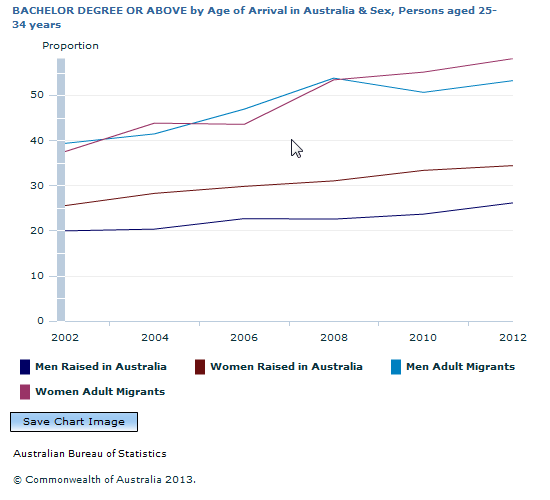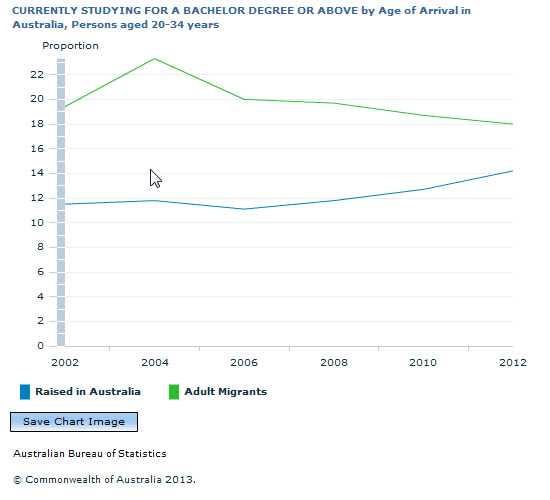4211.0 - Education and Training Newsletter, April 2013
ARCHIVED ISSUE Released at 11:30 AM (CANBERRA TIME) 10/05/2013
Page tools:
 Print Page Print Page
 Print All Print All
| |||||
|
In 2009, in recognition of the importance of higher education to economic and social progress, the Australian government set a target that by 2025, 40% of people aged 25-34 years would have a Bachelor degree or above (1). Since 2002 the proportion of this group with a Bachelor degree or above (hereafter referred to as a university degree) increased from 25% to 37% (in 2012) – an increase of almost 50% – indicating that Australia should achieve this target. The educational attainment of migrants has increased, driven by an increased emphasis on skilled migration (2). This article looks at what is influencing the increase in university degree qualified adults by examining trends of migrant and non-migrant groups and exploring whether migrants are completing their education in Australia or overseas.
 IS MIGRATION DRIVING THE INCREASE IN BACHELOR DEGREE ATTAINMENT? From 2002 to 2012 the proportion of people with a university degree has been higher for adult migrants than for people raised in Australia. In 2012, 56% of adult migrants had a university degree, while 30% of people raised in Australia had an equivalent qualification. The contribution of adult migrants to the Bachelor degree attainment rate has doubled in the last decade. In 2012, 4 out of 10 people aged 25-34 years with a university degree were adult migrants (39%), compared with 2 out of 10 people in 2002 (20%). Adult migrants contribute more to the Bachelor degree attainment rate now than a decade ago, in part because the proportion of adult migrants within the population aged 25-34 years has increased (from 13% in 2002 to 26% in 2012), and in part because the proportion of adult migrants with a university degree has increased (from 38% in 2002 to 56% in 2012). The increase in the proportion of adult migrants with a university degree (17 percentage points) is considerably higher than the increase in the proportion of people raised in Australia with a university degree (8 percentage points). While many migrants remain in Australia, and contribute to the knowledge and skills available in the labour market and more broadly, some people only reside in Australia temporarily. The 2010 General Social Survey (5) shows that temporary residents, including international students, account for 14% of 25-34 year olds with a university degree. In other words, temporary residents contributed 5 percentage points to the national Bachelor degree rate, which was 35% in 2010 (6). Some of these temporary residents will ultimately remain in Australia but the number who will is unknown. IS THERE A DIFFERENCE FOR MEN AND WOMEN? The proportion of people with a university degree has increased for men and women over the last decade. In 2012, 41% of women and 33% of men had a university degree (an increase of 13 and 11 percentage points, respectively, from 2002). Of people raised in Australia, a higher proportion of women than men have had a university degree throughout the last decade. In contrast, there has been little difference between male and female adult migrants. Data from the 2012 Survey of Education and Work found no statistically significant difference between the percentage of female (58%) and male (53%) adult migrants that had a university degree (7). Nevertheless, migrants contribute more to the Bachelor degree attainment rates of men than women. In 2012, 41% of men and 37% of women with a university degree were adult migrants.  ARE MIGRANTS GAINING THEIR QUALIFICATION IN AUSTRALIA OR OVERSEAS? The 2010-11 Survey of Learning and Work (8) shows that of adult migrants, 40% arrived in Australia with a university degree and a further 17% gained a degree after arrival (9). Furthermore, looking at trends in current study, a higher proportion of adult migrants than people raised in Australia were undertaking higher education. In 2012, 18% of adult migrants aged 20-34 years were studying at this level compared with 14% of people of this age raised in Australia (10).  From 2013, information on visa status and citizenship is expected to be available from the Survey of Education and Work, enabling further investigation of this topic. End Notes: (1) See Review of Australian Higher Education at the Department of Industry, Innovation, Climate Change, Science, Research and Tertiary Education website for further information on higher education policies. (2) Perspectives on Migrants (cat. no. 3416.0), 2009, Skilled Migration. (3) See Education and Work, Australia (cat. no. 6227.0) for further information. (4) Age at arrival in Australia is based on whole year calculations. For example for 2012 data, migrants aged 25 years were categorised as arriving in Australia aged 15 years or over if they arrived in 2002 or later. If they arrived prior to 2002 they were categorised as arriving in Australia aged 0-14 years. (5) See General Social Survey: Summary Results, Australia (cat. no. 4159.0) for further information. (6) Migration, Australia (cat. no. 3412.0), 2009-10. (7) At the 95% confidence level. (8) See Learning and Work, Australia (cat. no. 4235.0) for further information. (9) Approximately 4.7% of adult migrants had gained a university degree both before and after arriving in Australia. (10) Data from the 2012 Survey of Education and Work. Document Selection These documents will be presented in a new window.
|
||||
